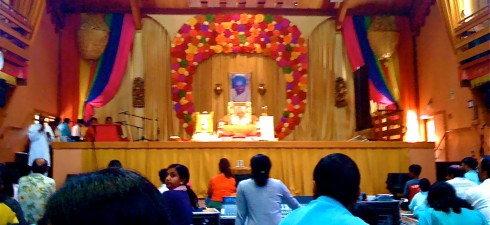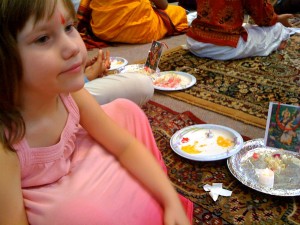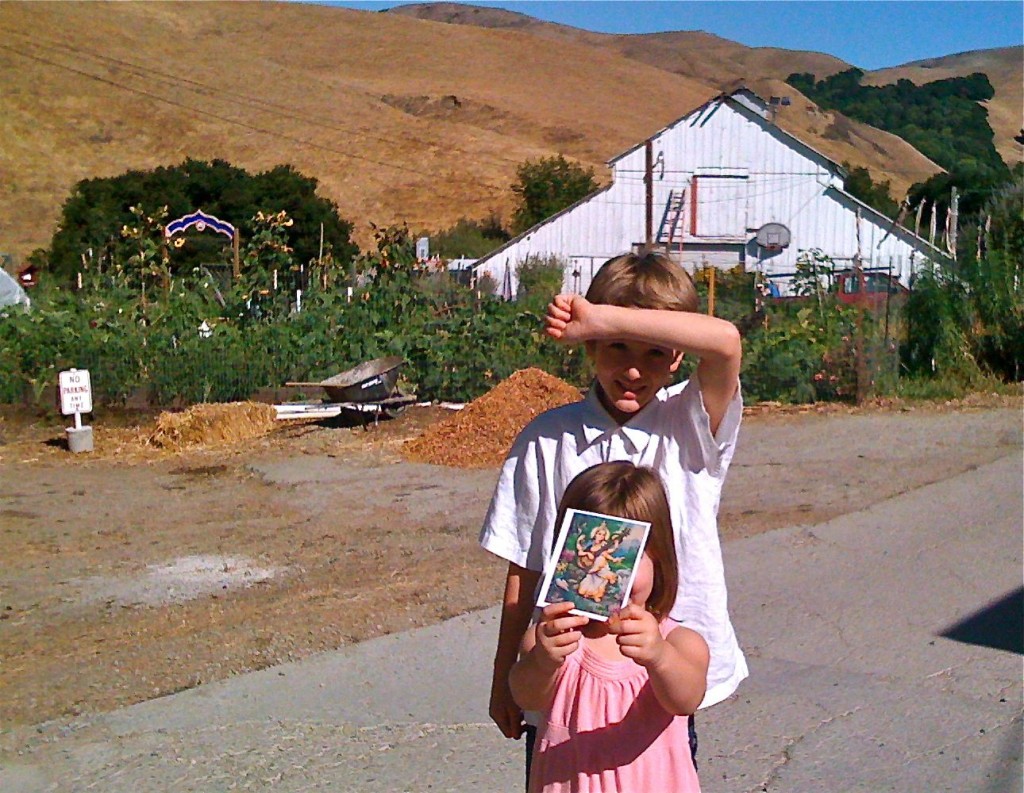“What does God look like?” I asked my little girl as I tucked her into bed. “Well, he is old, and he has a beard, and wears a. . ..a white dress,” she said. “A-ha,” I answered. “How do you know that?” “That’s what they told me at church,” she said. “And what does Heavenly Mother look like?” I asked. “Well, she has long hair, and. . ..” Her eyes searched the corners of the room for the image, ” and. . … I don’t know. They didn’t teach me that at church.” She leaned in and whispered, “You know, not everybody thinks she’s real. She’s a secret.”
At five years old, my daughter had tapped into one of the great nuances of the Mormon religion — the Feminine Divine is at best, a whisper. Despite talking about Mother in Heaven and praying to her, my daughter has noticed that our family is not the norm. She has noticed that the Mother is to be whispered about in private and not spoken of. She has no image of this mother in her mind’s eye.
The more I reflected on it, the more I wondered, “Just how is this girl going to grow up and see her potential, her wholeness, her power and divinity — if she can’t even conjure up an image of Mother in Heaven in her very active five-year-old imagination?”
Exploring the many different Avatars and their symbolism gives me the opportunity to understand specific aspects of God. I love the Mormon Heavenly Father — a God who is warm and loving; a great listener, and sometimes a great communicator. I am fascinated with Brahma the creator, Vishnu the sustainer, and Shiva the destroyer and the the circle of life that they represent. I am wild for Jesus, the ultimate bhakti yogi, and his radical call for complete love and acceptance. Each deity illuminates something unique about the Divine, and gives me a way to name just a tiny part of the un-nameable. Avatar allows me to see the invisible, even if it’s just a tiny glimpse.
It seemed like time to be a bit more adventurous with avatar, so I decided to take my younger two kids to the MA Center — The San Francisco Bay Area Satsang, to offer puja to Saraswati, the Goddess of knowledge, music, and the arts in preparation for the first day of school. The kids have had Father’s blessings to prepare them for school before, why not cover all of our bases, and receive a blessing from the wise Saraswati herself?
The MA center, home of Ammachi — the Hindu “hugging saint” was beautiful, hidden just a few minutes outside of town and tucked between some rolling hills behind a horse ranch. We entered the main building and removed our shoes just like at the yoga studio. So far, so good. As we entered the hall my 10-year old son gave me a look as if to tell me that he knew we were the minority in the room, and he wasn’t comfortable. “Good,” I thought. “Everybody should feel this sensation and understand what it’s like to be the minority in a room.” My 5-year old daughter, on the other hand, was instantly taken with the Indian children moving about the room in their bright saris and sparkly jewels. Everyone was very smiley and welcoming, and I was awestruck by these beautiful families, all joining as a community to support their children’s upcoming school year. It was clear that this is a culture that values education, that families and peace. The family atmosphere and big smiles felt just like a Mormon Sacrament Meeting — except much, much more colorful. And we wore pants. And we sat cross-legged on the floor. And oh yeah, that’s right — we were there to worship the Mother Divine!
After singing bhajans with the group, we sat and listened to a talk about the center: “This MA center is the Mother’s Home. It’s not rigid. We’re open 24/7 so you can come and walk around, enjoy the gardens, and receive an embrace whenever you need one”. Before invoking the Goddess, we were guided to present puja to Ganesha to remove any obstacles between ourselves and Saraswati. Next, we offered puja to Atman, to “wake up God within, who lives most easily within your heart.”
A man with a microphone led us through the process of giving puja, step-by-step, while a woman dressed in a white robe demonstrated the puja, offering gifts to a large framed image of Saraswati, while we did the same with our own mini version. We went through a process of offering a laminated little paper image of the Goddess sips of water, a garland, food and sweets. We placed yellow and red powders on her forehead, and on our foreheads. We lovingly sprinkled flower petals over her.
I looked at my daughter too late, and hoped she wasn’t the only little Christian in the room who delighted in painting her whole face with the pretty red powder, rather than just her third eye! My son was not so enthusiastic, looking up at me with terrified eyes, as if afraid to do it ‘wrong.’ He caught on quickly, taking it all in with the reverence of a well-trained Mormon primary kid. He carefully placed the powder on his forehead and listened intently. The conscientious 10-year old in him seemed to be hoping that this Saraswati did indeed have the power to bless him to succeed this year at school.
 After using all of our earthly senses of seeing, hearing, feeling, tasting, and smelling, the man leading the puja transitioned from the tangible world to a more subtle experience. He gave us the opportunity to ask the Goddess to be present. Offering the love in our hearts, the phrasing was, “Please come — you are my mother, I will not settle for anything less.” As we offered our hearts to the Divine Mother and accepted her blessing of wisdom for the upcoming school year, I couldn’t help but wonder what my teenage son and husband were experiencing across town in Sacrament meeting, and realized sadly that as wonderful as the meeting might be, they were settling for something less.
After using all of our earthly senses of seeing, hearing, feeling, tasting, and smelling, the man leading the puja transitioned from the tangible world to a more subtle experience. He gave us the opportunity to ask the Goddess to be present. Offering the love in our hearts, the phrasing was, “Please come — you are my mother, I will not settle for anything less.” As we offered our hearts to the Divine Mother and accepted her blessing of wisdom for the upcoming school year, I couldn’t help but wonder what my teenage son and husband were experiencing across town in Sacrament meeting, and realized sadly that as wonderful as the meeting might be, they were settling for something less.
Six weeks later, as I tuck my daughter into bed, I ask her, “What does Mother in Heaven look like?” She says, as if bored with the question, “I don’t know Mom.” “Do you think she looks like Saraswati?” I offer. “NO, Mom!” she says incredulously, “Heavenly Mother does NOT have four arms!”
And so we end up back at the mystical unknown of our Mother in Heaven. When I reflect on the amazing women in my life and all that they are able to accomplish, the symbolism of a Goddess with four arms is not wasted on me. I’m hopeful however, that my daughter’s rejection of these two extra limbs means that somewhere deep in her mind’s eye, exists a Mother in Heaven who looks something like she does. Such an image might be the perfect mirror for this little girl, showing her Atman — the Goddess within.
Until then, I’ll just keep asking her the same question I’m asking you today: Do you have a go-to Goddess? An instant image in your mind of the Feminine Divine? Tell me — what does she look like?




Laurie,
This is beautiful! I’m so glad you took your children to see the divine feminine.
I’m not sure I have a go-to Goddess, but I did read a book recently (At the Root of this Longing) which described Draupadi, a woman with the inner divine power to save herself and her people. I was impressed that this story is part of Indian culture and represents women’s power in some way.
I’d like to take my sons to something like this. I’ll have to do some research about where I could go in my own community. I have a friend from India who could probably help.
I like the use of different images and goddesses to fill in the blank of the Feminine Divine. My go-to has been Parvati – I remember reading her story and loving the duality she represented, that we can be both soft and strong at the same time. But when I think of Mother in Heaven, I see something very surprising as well. I see a warrior goddess with the hopeful ability to fight for her own representation, perhaps off in battle elsewhere for the cause of equality and waiting until we call to her for her to come to us. I see her as the one who will burn the world and cleanse it of the pain caused by patriarchy. Somehow I am able to envision something stronger in her than I can imagine in my own life; even more dramatic and harsh than I usually am about spiritual symbols, not sure why.
The Hindu religion has it’s version of sexism interwoven through it’s stories, but I’ve been really moved by how the many female deities offer so many versions of feminine divine. It illustrates woman as goddess, owning strength, fierceness, sexuality, charm, and beauty. These stories remind me that as a female, I am from the same divinity as man – the infinite source that moves through us all. In my eyes, source has no gender – but pours itself into our form to experience itself through embodiment.
This is the link to my Go-to Goddess: http://th06.deviantart.net/fs71/300W/i/2010/068/2/b/Triple_Goddess_by_Wolfnixie13.jpg
Its always want I look for when I want to find an image that encompasses the youthful and strong, the loving and fierce and the experienced and wise leader that I believe is Heavenly Mother. Its not perfect, as it shows the goddess in the triple aspect, but its the closest I’ve found to what I picture in my mind. I wish I had the talent of an artist to bring out the picture in my mind.
I love that you have such a clear image!
Thank you for this, Laurie! I don’t have a very clear image yet of the Divine Feminine. Its something I’m still working on. This post helped. :-)
“Please come — you are my mother, I will not settle for anything less.”
That might be the most wonderful phrase I’ve read in a long time. Thank you for sharing your experience!
Namaste !!!
I just bumped into your blog , dont know how… :) :) … but I just want to convey lots of blessings to you and your family..
With love from India
I worship the Virgin Mary, she gave birth to Jesus – Savior. Virgin Mary is – Heavenly Mother.
Mary is not with four arms (as monster). Mary is a beautiful woman as goddess.